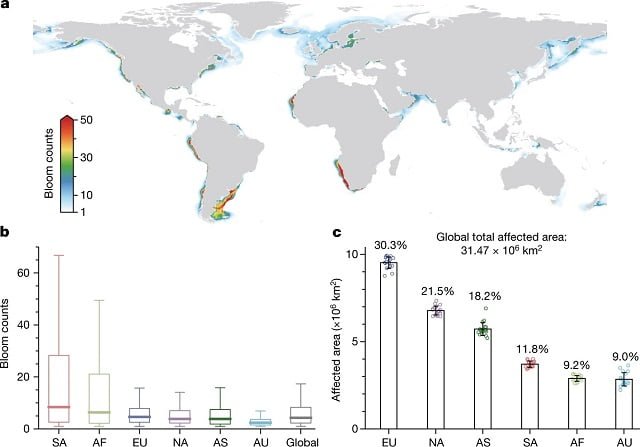
A team of scientists from the Southern University of Science and Technology, the University of South Florida, the Shenzhen Ecological and Environmental Monitoring Center of Guangdong Province, the Woods Hole Oceanographic Institution, and the University of Delaware, found that coastal blooms of algae have increased in the last two decades.
In the study, the researchers analyzed satellite data provided by NASA to compare the size and frequency of algal blooms along the coastlines of all the world’s continents.
Algal blooms
Algae blooms are accumulations of algae in certain areas of the coast; and they grow as their “food” sources increase, particularly nitrogen and phosphorus, both of which are supplied indirectly through human sources, such as fertilizer runoff.
Previous research has shown that algal blooms can be beneficial, fix carbon at the bottom of the food chain, and support fisheries and ecosystems around the world.
However, damaging algal blooms have become the biggest environmental problem worldwide.
In fact, the toxins produced by some species of algae can accumulate in the food chain, causing the closure of fisheries, as well as disease or mortality of marine species and humans.
In other cases, algal blooms can deplete oxygen in waters, and form anoxic areas “dead zones” that can cause fish and invertebrate deaths, and ecosystem restructuring.
Algal bloom events are increasing
In the new study, the researchers found evidence that algae blooms are increasing, suggesting that fertilizer runoff has been on the rise.
The work included the study of satellite images obtained from NASA’s Aqua satellite during the years 2003 to 2020.
“We found that algal blooms occurred in 126 of the 153 coastal countries examined. Globally, the spatial extent (+13.2%) and frequency (+59.2%) of blooms increased significantly during the study period,” they report.
By comparing the record of red tides over time, they found that they were increasing at an increasing rate of 59.2% globally.
The researchers also found that in the year 2020, the combined size of all algal blooms in the ocean was 31.47 million km2, which, they note, is about 8.6% of the total ocean area.
Natural and anthropogenic effects
Increases in sea surface temperature can stimulate the occurrence of blooms.
“We found significant positive correlations between average bloom frequency and sea surface temperature in several high-latitude regions,” they report.
They also indicate that changes in climate also affect ocean circulation, altering ocean mixing and nutrient transport, which promote the growth of marine phytoplankton and the formation of blooms.
“We looked at trends in fertilizer use and frequency of blooms; we found high positive correlations in China, Iran, Vietnam, and the Philippines. Paradoxically, the decrease in the use of fertilizers and the increase in flowering frequencies were identified in some countries”, they describe.
The researchers highlight that the intensification of the aquaculture industry in Finland, China, Algeria, Guinea, Vietnam, Argentina, Russia, and Uruguay could also be linked to the increase in the incidence of blooms, suggesting significant positive correlations between the expansion of the aquaculture and the frequency of blooms.
Conclusion
“The major contribution of our study is to provide a special and temporal characterization of coastal algal blooms around the world, between 2003 and 2020. Globally, there is an apparent increasing trend in algal bloom area and frequency,” they conclude. the researchers.
Finally, they highlight that considering that most blooms are beneficial, particularly in terms of their positive effects on ecosystems, in addition to fisheries and aquaculture, the results can contribute to the development of policies and management actions that sustain the benefits of the blooms.
Contact
Lian Feng
School of Environmental Science and Engineering
Southern University of Science and Technology,
Shenzhen, China
Email: fengl@sustech.edu.cn
Reference (open access)
Dai, Y., Yang, S., Zhao, D. et al. Coastal phytoplankton blooms expand and intensify in the 21st century. Nature (2023). https://doi.org/10.1038/s41586-023-05760-y

